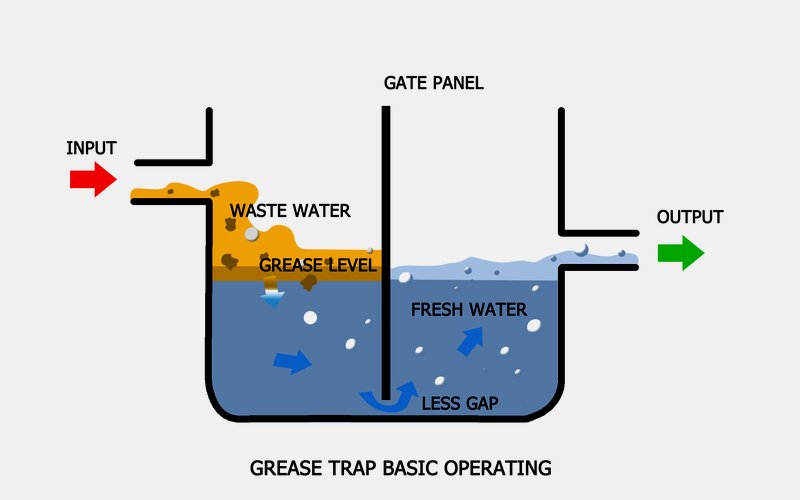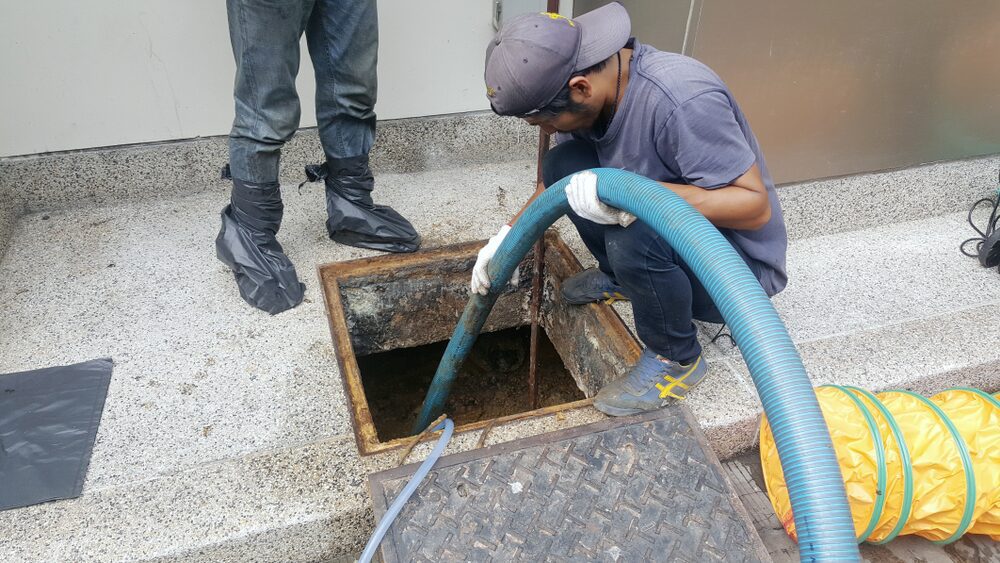What Could Occur If a Grease Trap Isn’t Properly Maintained
If a grease trap isn’t properly maintained, it can quickly become a costly headache. Blocked pipes, foul odors, and even health violations are just the start.
Keeping up with regular cleaning helps you avoid these issues and keeps your kitchen running smoothly.
What could occur if a grease trap isn’t properly maintained?
Neglect leads to clogged pipes, foul odors, health violations, fire risks, costly repairs, and environmental fines.
Key Takeaways
- Regular grease trap cleaning prevents costly backups, foul odors, and health violations.
- Clean traps protect plumbing, reduce fire risk, and avoid environmental fines.
- Busy kitchens should clean monthly; lighter use can stretch to every 2–3 months.
- Professional cleaning is safer and more thorough than DIY for most businesses.
What Is a Grease Trap and How Does It Work?

A grease trap is your kitchen’s unsung hero. It sits quietly under the sink or floor, catching fats, oils, and grease (aka FOG) before they mess with your plumbing.
Here’s how it works: greasy water flows in, solids sink, oil floats, and cleaner water slips out the back. Think of it like a bouncer at the door—only the chill stuff gets through.
If you’re running a restaurant or cooking heavy at home, this little box is doing serious work behind the scenes. But it needs backup.
When it’s full or clogged, that grease has nowhere to go. Pipes get blocked, smells start creeping, and you’re looking at downtime and fines. Not fun.
Moral of the story? Know what it is, check it regularly, and clean it before things get gross. Your plumbing—and your nose—will thank you.
Signs Your Grease Trap Isn’t Being Maintained
Something smells off? That sour, lingering funk around your sink isn’t random—it’s grease trap buildup doing its worst.
Slow drains are another red flag. If water’s backing up like it’s stuck in traffic, your trap might be packed to the brim.
Spotting grease in places it shouldn’t be? That’s a leak or overflow waiting to wreck your plumbing.
You might even hear weird gurgling sounds. Yep, your pipes are literally crying for help.
And if your kitchen staff’s dodging that corner of the room, it’s probably not a ghost—it’s sludge stench.
Quick fix? Get a pro to inspect and pump it. Better yet, schedule regular cleanouts before things go full horror movie.
A well-kept trap means fewer breakdowns, smoother kitchen flow, and zero nose-holding. Don’t sleep on it.
The Consequences of Poor Grease Trap Maintenance
Skip your grease trap maintenance and you’re basically inviting chaos into your kitchen—and your wallet.
1. Nasty Backups and Floods
Let the grease sit too long and it solidifies. That thick, gooey mess clogs your plumbing faster than you can say “emergency plumber.”
Water backs up, sinks overflow, and suddenly your kitchen smells like hot garbage. Not the vibe.
2. Health Code Violations (aka Fines and Embarrassment)
Health inspectors don’t play. If your trap’s a mess, expect a citation—or worse, a shutdown. That could mean lost business, bad reviews, and your team side-eyeing you hard.
3. Funky Odors That Linger
Rotting food scraps and trapped grease create smells that even the best air fresheners can’t fix. Your customers won’t want to stick around if it smells like a backed-up fryer in here.
4. Fire Risk from Grease Buildup
Grease is flammable. If it leaks out or builds up in weird spots, you’re one accident away from a kitchen fire. You’re not trying to turn your place into a cautionary tale on local news.
5. Sky-High Plumbing and Repair Bills
Neglect now, pay triple later. Blocked pipes and damaged traps cost way more to fix than to clean. Plus, you might need emergency service—aka after-hours pricing. That’s the opposite of a flex.
6. Environmental Damage (and Legal Trouble)
When grease escapes into the sewer system, it messes with local water treatment and clogs city lines. That’s not just bad for the planet. It can also get you fined by local authorities.
7. Lost Business and Bad Reputation
Word spreads fast. A stinky, unsanitary kitchen or surprise closure? That’ll kill your regulars’ trust real quick. Once your rep’s fried, it’s hard to get it crispy again.
The Fix? Keep It Simple.
Get on a regular cleaning schedule. Don’t wait for signs—it’s cheaper and easier to stay ahead of the mess. Think of it like changing your oil. Boring? Maybe. But skip it and things get ugly fast.
Bottom line? Your grease trap isn’t glamorous, but it’s doing the dirty work to keep your place running. Show it some love.
How Often Should a Grease Trap Be Cleaned?
Short answer? Every 1 to 3 months. But it depends on how much grease your kitchen churns out.
If you’re running a busy spot with deep fryers working overtime, monthly cleanouts are your best friend. Smaller cafés or low-grease operations can usually stretch it to every 2–3 months.
There’s also the “25% rule.” Once grease fills a quarter of the trap, it’s time to clean. Push past that, and you’re basically begging for backups, fines, or worse—foul smells killing the vibe.
Don’t just guess. Schedule cleanings, set reminders, and keep a log. Your future self (and your plumber) will thank you.
Benefits of Regular Grease Trap Maintenance

Let’s be real—nobody wants to deal with a kitchen that smells like a clogged sewer. Keeping your grease trap clean saves you from that nightmare. No backups. No funky odors. Just smooth kitchen vibes.
You’ll also dodge surprise bills. Routine cleaning keeps plumbing and equipment running right, which means fewer repairs and emergency calls. That’s money in your pocket, not down the drain.
Health inspectors? They’ll love you. A clean trap means your kitchen stays in compliance and off their radar. That’s one less thing to stress over.
It’s also better for the planet. Less gunk slipping into the water system means fewer fines and cleaner waterways. Good karma movie.
And here’s a flex—your kitchen runs like a well-oiled machine. Staff moves faster, dishes stay clean, and service doesn’t skip a beat. Grease trap on point? That’s low-key power.
In short: clean trap, clean rep, clean wallet. Stay sharp.
DIY vs. Professional Grease Trap Cleaning
DIY sounds like a money-saver, but scrubbing grease traps isn’t just gross—it’s risky if you don’t know what you’re doing. One wrong move, and you’re staring down fines or a nasty backup.
Pros bring the gear, the know-how, and zero mess left behind. They’ll clean it right and spot issues before they blow up your plumbing.
If your trap’s small and you’re consistent, DIY might work short-term. But for most spots, calling in the pros is the real cheat code. Spend less time elbow-deep in sludge, more time doing literally anything else.
Frequently Asked Questions
1. What happens if I skip grease trap cleaning?
You’ll end up with clogs, kitchen stink, and surprise fines. It’s not cute or cheap.
2. How often should I clean it?
Every 1–3 months, depending on how much you’re cooking. Don’t wait till it backs up.
3. Can I clean it myself?
You can, but it’s nasty. Most people call a pro to handle the sludge.
Conclusion
Skip the headache and just clean the trap. Seriously, it’s cheaper than plumbing repairs or city fines. Regular grease trap maintenance keeps your kitchen flowing, your drains clear, and your vibes unbothered.
